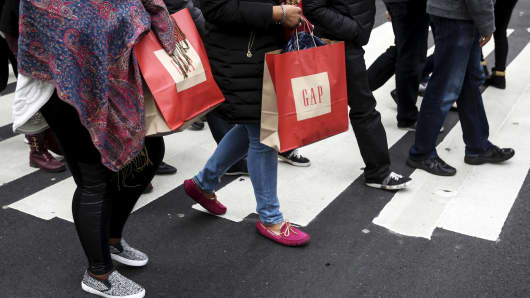The National Retail Federation said Friday that holiday sales increased 3 percent to $626.1 billion in November and December, falling short of the trade group’s forecast for 3.7 percent growth, as unseasonably warm weather and low prices weighed on results.
The news came shortly after the Commerce Department said retail sales posted an unexpected drop in December, falling 0.1 percent from the previous month. Compared with the prior year, December sales rose 2.2 percent, to $448.1 billion, according to the government data.
During the October to December period, total sales rose 1.8 versus the prior year, according to the department. Total sales for all of 2015 increased 2.1 percent, representing their weakest result since 2009, Reuters said.
“Make no mistake about it, this was a tough holiday season for the industry,” said NRF President Matthew Shay. “Weather, inventory challenges, advances in consumer technology and the deep discounts that started earlier in the season and that have carried into January presented stiff headwinds.”
“Despite these factors, the industry rallied, consumers responded and sales still grew at a healthy rate.”
How the industry generated this growth, however, remained a top concern among analysts. They cautioned that profitability will likely take a hit when retailers start rolling out their fourth-quarter earnings results in coming weeks, thanks to aggressive discounts.
“Knowing that the topline growth was fueled by promotions tells us that the real number for us to focus on is … the individual bottom-line results for retailers, because that’s where we’re going to see the real profitability numbers,” said Steve Barr, PwC’s U.S. retail and consumer leader.
Industry forecasts had called for modest sales growth this holiday season, as low gas prices and a stronger economy battled against muted wage gains and higher rent and health-care costs. Retailers that cater to middle-income shoppers faced even more headwinds, including price deflation and a shift in consumer spending toward dining out or travel.
As a result, the National Retail Federation predicted retail sales excluding autos, gas and restaurants would increase 3.7 percent in November and December, compared with the prior year’s 4.1 percent growth.
In the same vein, consulting firm AlixPartners forecast holiday sales (excluding motor vehicles, food services and dining, and gas stations) would rise 2.8 to 3.4 percent during the final two months of the year, compared with 4.4 percent growth in 2014.
And Deloitte, whose prediction covers the November through January period (but excludes motor vehicles and gasoline) predicted a 3.5 to 4 percent increase. That would mark a slowdown from its recorded 5.2 percent gain the prior year.
As the season progressed, however, analysts grew more pessimistic that sales would meet these forecasts. Despite retailers’ best efforts to get shoppers into their stores earlier, November got off to a slow start. Then, over the critical Black Friday weekend, ShopperTrak data indicated that sales fell an estimated 10.4 percent.
What’s more, unseasonably warm weather through December took a huge bite out of retailers’ traffic and sales, with Planalytics calculating a $572 million sales loss for specialty apparel stores during the final two months. That figure does not even take into account department stores, which also rely heavily on apparel. In its holiday sales release,Macy’s blamed 80 percent of its 4.7 percent same-store sales decline on cold-weather goods.
Retailers including Gap, Urban Outfitters, Best Buy and Zumiez also struggled during the holiday period. On the flip side, strength from names including Lululemon, L Brands, Five Below, The Children’s Placeand Express revived hopes that retail sales would come in line with early forecasts. Ken Perkins, president of Retail Metrics, told CNBC last week that early results were coming in “better than feared.”
Among the troubled categories, sales at electronics and appliance stores fell 2.4 percent over the past 12 months, while department store revenues dropped 2 percent, according to the Commerce Department. Sales at clothing and accessories stores increased 2.1 percent, likely due to steep discounts and strong trends in athletic apparel, Barr said.
Online sales continued to be a standout, though softer-than-expected results from desktop computers caused preliminary numbers at comScore to come in just shy of expectations. The analytics firm said last week that it now expects overall online sales to increase 13 percent, compared with its forecast for 14 percent growth.
According to the NRF, online sales grew 9 percent to $105 billion.
“I think the news from today really tells us that we’re at a tipping point,” Barr said Friday. “The consumer will spend with the retailers that have the right products and the right experiences both in-store and online, but there’s a separation occurring.”
He added that he expects that separation to flow through to individual retailers’ respective profitability.
“The high-performers on the topline, we expect them to report strong [earnings] results because they were the retailers that did not have to play the promotion game.”
On the flip side, Marcum’s Ron Friedman said the retailers who routinely offered 50 to 70 percent off will suffer. He did, however, predict some of these companies will nonetheless manage to eke out a profit, as a result of cost savings.
“It’s nothing to see 70 percent discounts, which means the stores are selling [the product] for less than cost,” he said. “They’re just turning over inventory to create cash flow.”
Investors will have a better indication of which retailers outperformed — and underperformed — come February, when major companies release their fourth-quarter earnings. Analysts remain cautious on companies with exposure to apparel, particularly as it relates to their profitability.
“[Retail’s] earnings growth is still limited,” Perkins said.
Correction: NRF revised its initial report. This story has been updated to reflect that holiday sales increased to $626.1 billion.
[“source -pcworld”]







